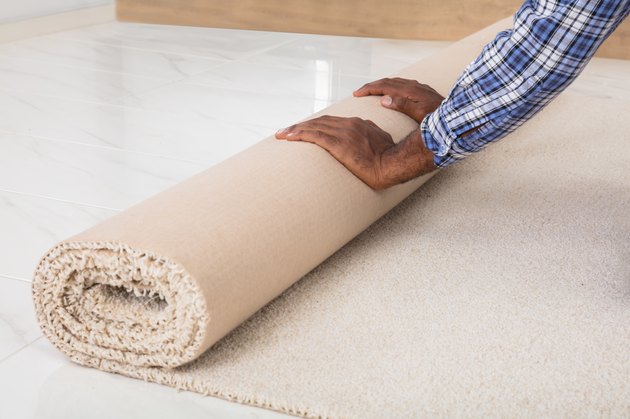While your carpets don’t have an expiration date, several signs indicate it may be time to replace that floor covering. Threadbare areas, warping or stretching, and odors or stains that do not go away no matter how often you clean the carpet are all clues that it may be time to replace that old carpet.

Video of the Day
Age Matters
While a carpet may not need to be replaced just because it’s old, a typical lifespan for modern carpeting is five to 15 years, depending upon the quality of its construction and the amount of foot traffic it receives on a regular basis. A carpet in a spare, rarely used bedroom will last longer than the same carpeting in the main hallway in your home, simply because it is rarely tread upon. Even in a seldom-used room, the padding beneath the carpeting may deteriorate over time, especially if it’s not of high quality. Once the padding deteriorates, the carpeting may feel lumpy or not as comfortable underfoot, and it may wear out more quickly.
Flattened Fibers and Contorted Carpets
If your carpet’s pile once stood tall but now looks flat and matted in some areas no matter how hard you try to remedy the situation, the carpet may be past its prime. Polyester and olefin fibers are prone to matting, especially in the areas walked upon the most. Even Berber carpeting made from looped fibers may succumb to matting over time. If you’ve cleaned, combed and done all you could to fluff old carpeting back up, but nothing seems to help, it’s time to replace the carpet. A carpet that seems stretched beyond its original shape, creating ripples, warps and tripping points throughout the room, is also ready for replacement.
Threadbare Wear
Even a carpet with short fibers, designed to be durable and last for years, wears out eventually. If you can see horizontal threads of the backing material through the top of the carpeting in some areas, it’s time to replace that carpet. No amount of cleaning or fluffing will remedy the situation. Fraying along edges or in thinning areas of the carpet is another sign it’s time to take out the old and bring in the new. These types of wear are likely to occur in heavily used areas such as hallways, stairs and the footpath between frequently used rooms.
Shifting Shades
If the carpet’s shade is significantly lighter in one area than another, or if the entire carpet seems to be a different hue than when you purchased it, its fibers have faded. Age and exposure to sunlight, air and cleaning materials may change the color of dye on some carpet fibers. While fading alone may not be enough to warrant replacing the carpet if it still seems in fairly good shape, you may want to replace it if the color appears uneven or if it has other issues.
Scents and Stains
If you’ve just cleaned the carpet and it still smells like a wet dog — even if you don’t have a pet — it may be time to replace that funky floor covering. Carpet traps dirt, dust, debris and allergens, and over time, it becomes more difficult to remove all of the problematic materials even with a deep cleaning, which may also be an issue for those with asthma and allergies. As for stains, you may be able to hide a stain or two under furniture, but several stains that do not disappear even after professional cleaning may mean it’s time to consider a new carpet, especially if the stains are in a highly visible area and the carpet is past its prime.












